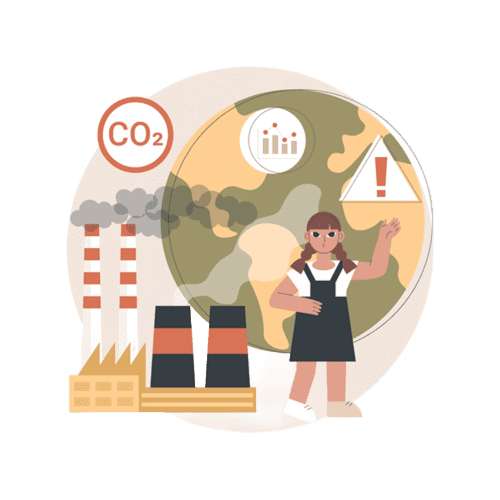[dsm_gradient_text gradient_text="Your AI Ready for the Future? Inside the New AI Maturity Model" _builder_version="4.27.0" _module_preset="default" header_font="Questrial|||on|||||" header_text_align="center" header_letter_spacing="5px" filter_hue_rotate="100deg"...
Corporate Environmental Sustainability: Rethinking Business Roles, Responsibilities, and Opportunities for a Greener Future
The climate crisis, biodiversity loss, and ecological degradation have pushed environmental sustainability to the top of the global agenda. Businesses, once seen as part of the problem, are now recognized as key players in the solution.

The recent special issue by Current Research in Environmental Sustainability offers a timely synthesis of how corporations can reshape their strategies, operations, and governance to align with sustainability imperatives. This transformation is not just a moral or regulatory obligation – it is a competitive necessity.
As environmental pressures intensify, so do expectations from investors, consumers, governments, and civil society. Corporate Social Responsibility (CSR), Environmental, Social, and Governance (ESG) factors, and sustainable finance have shifted from buzzwords to strategic frameworks. This article explores the evolving role of business in addressing sustainability challenges – highlighting insights from research, real-world case studies, and policy developments.
From CSR to ESG: A Paradigm Shift in Corporate Responsibility
Corporate Social Responsibility (CSR), once a peripheral marketing initiative, has evolved into a more robust, metrics-driven, and stakeholder-centric model – ESG. While CSR emphasized philanthropy and voluntary ethics, ESG embeds sustainability into core business operations, risk assessments, and reporting obligations.
Key ESG Developments:
- EU Sustainable Finance Disclosure Regulation (SFDR)
- Corporate Sustainability Reporting Directive (CSRD)
- EU Taxonomy for Sustainable Activities
These frameworks compel transparency, verifiability, and accountability. Companies must now disclose not only their direct emissions but also those financed (Scope 3), and how their business models align with environmental objectives.
In the past two decades, the corporate landscape has undergone a profound transformation in how businesses define, measure, and report their social and environmental responsibilities. What began as Corporate Social Responsibility (CSR) – often rooted in philanthropy, ethics, and public image – has evolved into a more structured, data-driven, and integrated framework known as Environmental, Social, and Governance (ESG). This shift signifies more than just a semantic upgrade; it reflects a broader rethinking of the role of corporations in society, fueled by stakeholder expectations, regulatory changes, and a growing urgency to address systemic risks such as climate change, inequality, and governance failures.
Understanding CSR: The Foundation of Ethical Business
Corporate Social Responsibility, or CSR, emerged in the mid-20th century as a way for businesses to acknowledge their ethical obligations beyond profit-making. Rooted in the idea that corporations should be good corporate citizens, CSR traditionally encompassed voluntary efforts like community engagement, charitable giving, ethical labor practices, and environmental stewardship.
Key proponents like Archie B. Carroll introduced models such as the CSR Pyramid, which described four levels of corporate responsibility: economic, legal, ethical, and philanthropic. CSR programs often existed in silos, disconnected from core business strategy. They were sometimes criticized as bolt-on initiatives that prioritized optics over impact – also known as greenwashing when environmental claims were unsubstantiated.
Nonetheless, CSR laid the moral groundwork for businesses to begin reflecting on their societal impact. It marked a significant step away from Milton Friedman’s shareholder primacy doctrine, which famously claimed that the only social responsibility of business was to increase its profits.
The Rise of ESG: Quantifying Responsibility
The transition from CSR to ESG represents a strategic and measurable evolution of corporate responsibility. Unlike CSR, which is often broad and voluntary, ESG refers to concrete environmental, social, and governance metrics used by investors, regulators, and companies to assess non-financial risks and opportunities.
The acronym ESG first gained prominence in the early 2000s, driven by the investment community. It was championed by initiatives like the United Nations Principles for Responsible Investment (PRI), launched in 2006, which urged institutional investors to incorporate ESG factors into their decision-making. ESG shifted the discussion from moral obligations to financial materiality — focusing on how sustainability issues impact business performance and long-term value creation.
ESG Breakdown:
- Environmental (E): Carbon emissions, energy usage, pollution, water management, biodiversity, and climate resilience.
- Social (S): Labor practices, human rights, community relations, diversity & inclusion, and product responsibility.
- Governance (G): Board structure, executive compensation, shareholder rights, transparency, anti-corruption, and risk management.
Where CSR was often viewed as optional and subjective, ESG is measurable, auditable, and comparable – making it highly relevant for investment decisions, corporate strategy, and regulatory compliance.
Why the Shift Happened
Several forces converged to push companies toward ESG integration:
1. Investor Demand: Institutional investors now prioritize ESG disclosures to evaluate long-term risks and growth prospects. BlackRock, the world’s largest asset manager, has made ESG integration a key investment principle, signaling a major shift in capital allocation.
2. Regulatory Pressure: Governments and international bodies have introduced stricter regulations. In the EU, the Sustainable Finance Disclosure Regulation (SFDR) and the Corporate Sustainability Reporting Directive (CSRD) require companies to report ESG metrics and assess environmental risks, particularly climate-related ones, in line with the EU Taxonomy.
3. Climate Crisis and Global Risks: Wildfires, floods, pandemics, and supply chain disruptions have shown that environmental and social risks are financial risks. ESG frameworks help quantify these risks and guide businesses in managing them.
4. Stakeholder Expectations: Employees, customers, and civil society are increasingly holding companies accountable for their social and environmental footprints. Modern consumers prefer brands that align with their values, and employees are choosing workplaces that reflect social purpose.
5. Digital Transparency: In a hyper-connected world, corporate actions are instantly visible and dissected. A lapse in ethics or sustainability can go viral and damage reputation overnight, giving companies even more incentive to integrate ESG into operations.
ESG in Practice: From Reporting to Strategy
The ESG approach is not merely about data reporting. It requires embedding sustainability into core corporate strategy, risk management, and decision-making processes.
Challenges and Criticism
Despite its strengths, ESG is not without criticism:
-
Lack of Standardization: ESG scores can vary wildly between rating agencies due to different methodologies.
-
Greenwashing: Some companies exaggerate or fabricate ESG efforts to attract investors.
-
Overemphasis on Disclosure: Critics argue that disclosure alone does not guarantee meaningful impact.
-
Trade-offs: Sometimes, improving performance in one ESG area may compromise another. For instance, shifting to electric vehicles reduces emissions but increases demand for lithium, raising human rights and environmental concerns in mining regions.
To overcome these challenges, clearer standards, third-party audits, and outcome-focused assessments are essential.
Looking Ahead: ESG as a New Business DNA
The CSR-to-ESG shift reflects a maturing understanding of corporate responsibility. It’s no longer about checking the “nice-to-have” box; it’s about future-proofing businesses, building trust, and contributing to a livable planet.
ESG is becoming embedded in the DNA of leading companies, influencing:
-
Corporate purpose and mission
-
Board diversity and accountability
-
Supply chain transparency
-
Product innovation that meets societal needs
Forward-thinking businesses recognize that ESG is not a cost but an investment – one that attracts capital, reduces risk, and unlocks innovation.
The transition from CSR to ESG marks a paradigm shift in how corporations engage with the world. It reflects a deeper alignment between profitability and purpose, and it equips businesses to address complex global challenges with transparency, integrity, and resilience. While CSR built the moral foundation, ESG constructs the strategic framework for a sustainable and inclusive future.
As we move further into the decade, ESG will continue to shape how companies are evaluated, trusted, and remembered – not just by investors, but by all of society.
Greenhouse Gas Accounting at the Sub-national Level
As the global community accelerates efforts to combat climate change, the importance of accurate and granular greenhouse gas (GHG) accounting has never been greater. While national-level emissions reporting frameworks have historically dominated climate policy discussions, sub-national GHG accounting – which includes cities, municipalities, and regional jurisdictions – has emerged as a critical frontier in the fight against climate change.
Sub-national entities are on the front lines of environmental governance, implementing transportation systems, managing energy infrastructure, enforcing building codes, and more. However, to design, execute, and measure the effectiveness of these policies, reliable and localized GHG data is essential. This essay explores the significance, challenges, and innovations in sub-national GHG accounting, drawing on current research, global frameworks, and real-world case studies.
Why Sub-national GHG Accounting Matters
Greenhouse gas emissions have global effects, but their sources and solutions are often local. Cities, for instance, are responsible for over 70% of global CO₂ emissions according to the UN-Habitat (2020), despite occupying only about 2% of the Earth’s surface. Sub-national GHG accounting enables regional authorities to:
- Understand localized emission sources
- Set realistic and data-driven reduction targets
- Monitor the effectiveness of local climate actions
- Attract funding and partnerships through transparency
- Align with international frameworks like the Paris Agreement
Without localized emissions data, climate strategies risk being inefficient or misdirected. Sub-national GHG accounting empowers local governments to tailor mitigation efforts to the specific conditions of their jurisdictions.
Frameworks and Methodologies
Several methodologies and tools have been developed to support sub-national GHG accounting. Two prominent ones are:
-
EDGAR (Emissions Database for Global Atmospheric Research)
- Developed by the European Commission’s Joint Research Centre
- Provides high-resolution gridded emissions data globally
- Useful for benchmarking and long-term trend analysis
-
BEI (Baseline Emission Inventory)
- Developed under the Covenant of Mayors for Climate & Energy, a European initiative
- Focuses on local-level energy-related emissions
- Typically used by municipalities in Europe to prepare action plans
These two frameworks serve different purposes. As highlighted in Palermo et al. (2024), EDGAR excels at global consistency and spatial coverage, while BEI offers a more policy-relevant breakdown by sector. However, they are not directly compatible, which limits the ability to integrate datasets or compare regions effectively.
Key Sectors and Emission Sources
Sub-national GHG accounting generally categorizes emissions into several key sectors:
- Municipal Buildings and Facilities: Emissions from government-run buildings and services.
- Residential and Commercial Buildings: Emissions from heating, cooling, and electricity use.
- Transport: Emissions from public and private vehicles, including road, rail, and air.
- Waste: Emissions from landfills, incinerators, and wastewater treatment.
- Industry and Agriculture (optional sectors): May be included depending on data availability and local relevance.
This sectoral breakdown enables local authorities to prioritize high-impact areas. For instance, a city with high car dependency might focus on public transport and walkability, while a rural region may target methane emissions from agriculture.
Challenges in Sub-national GHG Accounting
Despite its importance, sub-national GHG accounting faces significant obstacles:
- Data Gaps and Inconsistencies Sub-national authorities often lack access to high-quality, granular data. Data may be fragmented across agencies or not collected at all, especially in developing countries.
- Lack of Standardization Different regions use different methods, making cross-jurisdictional comparisons difficult. Without a common language for emissions, benchmarking and collaboration are hindered.
- Limited Technical Capacity Local governments may lack the expertise or resources to implement complex GHG accounting systems. This challenge is especially pronounced in smaller municipalities and the Global South.
- Temporal Mismatch Many methods use annual or even multi-year averages, which don’t reflect real-time changes or seasonal variations—leading to outdated or misleading conclusions.
- Exclusion of Scope 3 Emissions Many inventories omit indirect (Scope 3) emissions, such as those from imported goods or upstream electricity generation. These emissions are critical but difficult to track at a local level.
Opportunities and Innovations
Despite the challenges, there are exciting developments in the field:
- Satellite Monitoring and Remote Sensing
Advances in satellite data (e.g., through NASA and ESA missions) offer real-time, high-resolution GHG monitoring capabilities. Tools like Google’s Environmental Insights Explorer (EIE) help cities estimate emissions from transport and buildings using big data. - Open-source Tools
Platforms like ICLEI’s ClearPath, GHG Protocol for Cities (GPC), and Carbon Disclosure Project (CDP) Cities offer standardized, accessible tools for municipalities to start or refine their emissions inventories. - Integrated Climate and Air Quality Models
Some newer models assess co-benefits, such as how reducing CO₂ also cuts local air pollution, thus aligning climate action with public health goals. - Citizen Science and IoT Sensors
Community-led air quality and emissions monitoring projects are growing. These initiatives engage citizens while providing hyper-local data to improve inventories. - Policy Synergy
Regions are increasingly embedding GHG accounting into broader sustainability strategies, such as urban planning, infrastructure development, and resilience building.
The Role of Sub-national GHG Accounting in Global Climate Action
Sub-national GHG accounting is not just a local tool—it plays a vital role in global climate governance. Many climate pledges under the Paris Agreement rely on aggregated actions from cities and regions. Transparent local inventories contribute to nationally determined contributions (NDCs), ensure alignment with UN Sustainable Development Goals (SDGs), and support the Global Stocktake process under the UNFCCC.
Moreover, localized data helps build trust and accountability, attracting climate finance and encouraging citizen participation. It also enables cities to join global networks like C40 Cities, ICLEI, and the Under2 Coalition, which rely on robust data for collaboration and advocacy.
%
Greenhouse Gas Accounting
In 2024, the UK’s carbon emissions fell by 4%, reaching 371 million tonnes of carbon dioxide equivalent (MtCO₂e), down from 385 MtCO₂e in 2023, marking a 54% reduction from 1990 levels. Source: The Guardian
%
Consumer Expectations in the Age of Sustainability
A 2023 study revealed that more than 60% of businesses are off track to meet their current sustainability goals, indicating a growing consumer demand for corporate environmental responsibility. Source: WBCSD
Corporate Governance and Environmental Policies
Effective governance is the backbone of sustainability transformation. Companies with diverse, experienced, and accountable boards are more likely to embrace voluntary environmental standards such as ISO14001.
Findings from Japan-Thailand case study (Hirata et al., 2023):
- Longer business history and parent-company control correlate with higher ISO14001 adoption.
- Female board representation has little impact in Japan due to underrepresentation (4.6%).
Food sector case (Serrentino et al., 2024):
- Australian food companies scored poorly on sustainability practices (median score: 31/100).
- GHG reduction policies were stronger than water use and animal product sourcing policies.
Sustainability must be embedded in leadership DNA – via diversity, accountability, and strategic vision – not as an afterthought.
In today’s rapidly evolving business landscape, environmental sustainability is no longer a peripheral concern – it is a central aspect of corporate strategy and risk management. As such, corporate governance plays a pivotal role in shaping how environmental policies are adopted, implemented, and monitored within organizations.
Corporate governance refers to the systems, principles, and processes by which a company is directed and controlled. It includes the structure and function of boards, the role of shareholders, executive accountability, and internal controls. When aligned with environmental priorities, governance can transform sustainability from a set of lofty ideals into actionable policies embedded within corporate DNA.
The Governance-Sustainability Nexus
Effective corporate governance ensures that environmental risks – such as climate change, resource scarcity, pollution, and biodiversity loss – are not only recognized but actively managed. This includes:
- Board oversight of environmental strategies and ESG performance
- Transparent reporting on environmental impact and sustainability metrics
- Executive incentives linked to environmental targets
- Stakeholder engagement that includes communities, regulators, and investors
As seen in global standards like the OECD Principles of Corporate Governance and UN Principles for Responsible Investment, modern governance increasingly calls for environmental stewardship as a fiduciary responsibility.
Case Study: ISO14001 Adoption and Governance
A 2023 study by Hirata et al., published in Current Research in Environmental Sustainability, investigated how corporate governance characteristics influenced the adoption of the ISO14001 environmental management standard in Japanese companies operating in Thailand. The findings revealed that subsidiaries were more likely to adopt ISO14001 if their parent companies had longer operating histories, stronger voting rights, and more independent directors.
Interestingly, the proportion of female board members did not significantly affect adoption – a result attributed to the low female representation in Japan’s corporate boards (only 4.63%). This highlights the broader issue of board diversity and the need to reach a critical mass before underrepresented voices can influence environmental decisions.
The INFORMAS Framework: Assessing Environmental Practices
Another study by Serrentino et al. (2024) evaluated Australian food companies using a governance-based framework developed by the global INFORMAS network. The framework assessed policies in ten domains, including GHG emissions, biodiversity, water, packaging, and relationships with other organizations.
The results were mixed: while companies scored relatively higher on emissions reduction efforts (median score of 58/100), they fell short in areas like water use (23/100) and animal product sourcing (10/100). These findings indicate that even when governance structures are in place, comprehensive and balanced environmental policies are still lacking.
Corporate Governance and Environmental Policies: Aligning Oversight with Sustainability
Corporate governance is the bridge between sustainability ambition and execution. Boards and executive leadership must move beyond symbolic gestures and ensure that environmental policies are strategic, measurable, and fully integrated into corporate operations.
As pressure mounts from regulators, investors, and the public, companies with strong environmental governance will not only mitigate risk but also position themselves as leaders in a rapidly greening economy. Ultimately, the future of environmental sustainability rests not just in innovation or regulation – but in the boardroom.
The Rise and Role of Sustainable Finance
Finance is no longer neutral – it’s a lever for transformation.
Themes explored:
- Green bonds (Mitchell et al., 2024)
- Retail ESG investments (Horn, 2024)
- Emission accounting in investment portfolios (Atlason et al., 2023)
- Extractive industry investments (Zaehringer et al., 2024)
Challenges identified:
- Inconsistent accounting methods may lead to greenwashing
- Lack of clear taxonomy and verified data undermines trust
- The dynamic nature of investment portfolios complicates emissions attribution
Opportunities:
- Green bonds are shaping sustainable business models
- ESG disclosure is influencing capital allocation
Financial institutions must move beyond static year-end emissions reporting and adopt dynamic, time-sensitive models. — Atlason et al., 2023
Consumer Expectations in the Age of Sustainability
Consumers are not just end-users – they are sustainability stakeholders.
Key insights:
- Many consumers have unrealistic expectations about bio-based plastics (Fletcher et al., 2024)
- Packaging “usability” and “disposability” are valued more by consumers than industries realize (Sonck-Rautio et al., 2024)
Consumer knowledge gaps:
- Confusion between biodegradable and compostable
- Mistrust of corporate green claims
- Desire for meaningful, transparent labels
Businesses must go beyond compliance – develop intuitive, honest communication and education strategies to empower consumers.
In the age of climate consciousness and social accountability, consumer expectations are rapidly evolving, placing unprecedented pressure on businesses to demonstrate genuine sustainability. No longer content with surface-level commitments or greenwashing, today’s consumers seek authenticity, transparency, and impact from the brands they support.
A Shift in Consumer Consciousness
Consumers are more informed and values-driven than ever. Global surveys consistently reveal that a majority of people prefer to buy from companies that are environmentally responsible and socially ethical. According to Nielsen (2019), over 70% of consumers say they would pay more for sustainable brands. This shift is driven largely by millennials and Gen Z – generations that view sustainability as a baseline expectation, not a bonus.
However, while values are high, there’s often a gap between intention and action. This “attitude-behavior gap” reflects both systemic and market challenges. Many consumers want to make sustainable choices but face barriers like lack of clear information, higher prices, or limited availability of truly green options.
Confusion Around Sustainability Claims
One of the biggest frustrations for consumers is inconsistent or unclear sustainability labeling. As shown in the study by Fletcher et al. (2024), published in Current Research in Environmental Sustainability, many consumers remain confused about terms like biodegradable, compostable, or bio-based. This misunderstanding leads to unrealistic expectations and skepticism. If a product claims to be environmentally friendly but fails to perform or lacks clarity, trust is quickly eroded.
Companies must therefore invest in better communication and education, ensuring that sustainability claims are not only accurate but also understandable. Transparent labeling, third-party certifications, and customer engagement campaigns can bridge the trust gap and turn passive buyers into active sustainability advocates.
The Role of Packaging and Product Design
Sustainability expectations extend beyond ingredients and supply chains – packaging plays a significant role in consumer perceptions. In a study by Sonck-Rautio et al. (2024), also published in Current Research in Environmental Sustainability, Finnish consumers emphasized not only the environmental impact of packaging but also its usability and disposability – factors often overlooked by the industry.
Consumers are calling for solutions that don’t sacrifice convenience for sustainability. This means packaging that is not only recyclable but easy to sort and dispose of, or even reusable. Companies that incorporate user-friendly, low-impact design are more likely to succeed in a market that values both function and ethics.
Implications for Business
Meeting consumer expectations in the sustainability era is no longer optional – it’s a business imperative. Brands that fail to adapt risk losing relevance, while those that embrace sustainability authentically stand to gain customer loyalty, attract new markets, and strengthen brand equity.
To succeed, businesses must:
- Listen actively to consumer concerns
- Improve sustainability education and transparency
- Design products with the entire lifecycle in mind
- Engage consumers as co-creators in sustainability efforts
Consumer Expectations in the Age of Sustainability
Consumers today are not just buyers – they are stakeholders in the sustainability journey. As their expectations grow more sophisticated, so too must the efforts of businesses to meet them. In this age of accountability, the brands that thrive will be those that don’t just market sustainability – but embody it.
The Bioeconomy as a Pillar of Sustainable Transformation
The bioeconomy involves the sustainable use of biological resources for energy, food, materials, and services.
Key findings from Briers et al. (2024):
- Strong public/private support for the bioeconomy across 9 EU regions
- Implementation remains fragmented
- Environmental benefits are emphasized over socio-economic dimensions
Risks:
- Green grabbing of land
- Trade-offs between bioenergy and food security
- Technocratic policy disconnects from local realities
Integrated, region-specific strategies that respect local ecosystems, social equity, and economic needs.
As the world grapples with the challenges of climate change, biodiversity loss, and unsustainable resource consumption, the bioeconomy has emerged as a promising pathway toward a more sustainable, circular, and inclusive global economy. Rooted in the use of renewable biological resources – such as plants, animals, microorganisms, and organic waste – the bioeconomy aims to replace fossil-based products with bio-based alternatives while fostering innovation across sectors like agriculture, energy, health, and manufacturing.
What Is the Bioeconomy?
The bioeconomy refers to the production, utilization, and conservation of biological resources to provide goods, services, and energy. It encompasses bio-based materials (e.g., biodegradable plastics), sustainable agriculture and forestry, ioenergy (e.g., biofuels, biogas), and biotechnology-based innovations (e.g., bio-pharmaceuticals, synthetic biology)
Unlike traditional, linear economic models that depend on extracting and depleting finite resources, the bioeconomy promotes circularity, where biological waste can be reused, recycled, or repurposed – minimizing environmental impact while maximizing resource efficiency.
A European Perspective: Insights from Research
In a 2024 study by Briers et al., published in Current Research in Environmental Sustainability, researchers assessed how public and private sector actors in nine European regions perceive the bioeconomy. The findings reveal broad support for the concept, with stakeholders recognizing its potential to address environmental challenges while generating economic and social benefits.
However, the study also points to complexities in implementation, including:
- Varying levels of understanding of what the bioeconomy entails
- Sector-specific priorities and regional disparities
- Tensions between individual risk and collective benefit
For example, while many respondents valued the environmental advantages of a bio-based transition, they also expressed concerns about affordability, job security, and potential disruptions to traditional industries.
These insights suggest that for the bioeconomy to succeed, clear communication, inclusive policymaking, and regional customization are essential.
Environmental and Societal Benefits
The bioeconomy can support multiple Sustainable Development Goals (SDGs):
- SDG 12: Responsible consumption and production
- SDG 13: Climate action
- SDG 15: Life on land
By reducing dependence on fossil fuels, the bioeconomy contributes to lowering greenhouse gas emissions. It also fosters rural development by creating green jobs in agriculture, forestry, and bioprocessing. Moreover, it offers biotechnological solutions to health, energy, and environmental problems – from biodegradable packaging to plant-based meat alternatives.
Challenges and Considerations
Despite its promise, the bioeconomy is not a panacea. Concerns include:
- Land use conflicts (e.g., between food production and biomass)
- Resource inequality and potential displacement of small-scale farmers
- Greenwashing, where products are marketed as bio-based without real sustainability benefits
Addressing these challenges requires strong governance, lifecycle assessment tools, equitable value chains, and stakeholder involvement at all levels.
The Bioeconomy as a Pillar of Sustainable Transformation
The bioeconomy is more than a technological innovation – it’s a systemic shift toward a regenerative economy. When designed inclusively and governed responsibly, it holds the potential to become a cornerstone of the sustainable transformation we urgently need. As the climate and ecological crises deepen, investing in the bioeconomy is not just strategic – it’s essential for a resilient, low-carbon future.
Crosscutting Themes and the Interdisciplinary Imperative
Environmental sustainability research must break silos. This special issue demonstrates that climate accounting, finance, governance, and consumer behavior are interlinked.
Example intersections:
- GHG accounting overlaps with investment risk disclosure
- Governance affects green finance credibility
- Consumer expectations shape packaging innovation
Interdisciplinary research and transdisciplinary action (engaging stakeholders) are not optional—they are foundational.
Environmental sustainability is a deeply complex and interconnected challenge. Addressing it effectively requires not just action in isolated sectors, but a systemic approach that integrates multiple disciplines, perspectives, and scales. This is where crosscutting themes and interdisciplinary collaboration become essential.
Crosscutting themes refer to issues or topics that span across different domains – economic, social, environmental, and technological – and influence a wide range of sustainability efforts. These themes act as connective tissue between sectors, allowing for holistic understanding and integrated solutions. For example, climate change is not just an environmental problem; it intersects with public health, urban planning, agriculture, finance, and social justice.
The Value of Crosscutting Themes
One of the key insights from the 2025 special issue in Current Research in Environmental Sustainability is that sustainability research – and practice – must embrace interconnectedness. The papers covered in the issue highlight a range of topics: greenhouse gas (GHG) accounting, corporate governance, consumer behavior, sustainable finance, and the bioeconomy. While each addresses a specific domain, many issues emerge repeatedly across different contexts.
For example, GHG emissions are a recurring concern – whether in sub-national accounting (Palermo et al., 2024), investment portfolios (Atlason et al., 2023), or food industry policies (Serrentino et al., 2024). Similarly, stakeholder engagement arises in studies of both governance and consumer expectations, pointing to the critical need for transparency, participation, and equity.
Recognizing these crosscutting concerns enhances efficiency, avoids duplication, and promotes a more cohesive understanding of the sustainability landscape.
The Interdisciplinary Imperative
Sustainability challenges do not conform to academic or organizational boundaries. To develop effective responses, we need interdisciplinary collaboration that combines insights from environmental science, economics, sociology, engineering, policy studies, and more.
For example, implementing sustainable finance mechanisms (Horn, 2024) requires not only economic and regulatory expertise but also environmental data and social impact assessments. Likewise, understanding consumer behavior around biodegradable plastics (Fletcher et al., 2024) demands both psychological and material science knowledge.
Interdisciplinarity also helps tackle trade-offs and unintended consequences. A policy promoting electric vehicles may reduce emissions but increase demand for rare earth minerals, impacting biodiversity and human rights in mining regions. Only by engaging multiple disciplines can such ripple effects be anticipated and addressed.
Transdisciplinarity: Bridging Research and Practice
In addition to crossing disciplinary boundaries, sustainability efforts must also cross institutional ones. This calls for transdisciplinarity – collaboration between researchers, policymakers, businesses, and communities. It’s not enough for scientists to study problems in isolation; they must work with stakeholders to co-design solutions that are locally relevant and socially just.
Examples from the special issue, such as participatory research in the bioeconomy (Briers et al., 2024), underscore how practitioner insights enrich academic understanding and vice versa.
Crosscutting Themes and the Interdisciplinary Imperative in Environmental Sustainability
Sustainability is not a single-issue problem – it is a complex web of interconnected challenges. Embracing crosscutting themes and fostering interdisciplinary collaboration are not optional—they are imperative. Only through integrated thinking and cooperative action can we develop solutions that are scalable, equitable, and lasting. The future of environmental sustainability depends not just on what we know – but on how well we work together to connect the dots.
From Research to Action: Practical Implications for Business
What should companies do?
Strategies for sustainability integration:
- Adopt science-based targets and measure Scope 1–3 emissions
- Align reporting with CSRD and SFDR standards
- Train leadership and staff in ESG literacy
- Co-create solutions with consumers and communities
- Innovate with circular business models and product-service systems
Tools and frameworks:
- Global Reporting Initiative (GRI)
- Task Force on Climate-Related Financial Disclosures (TCFD)
- B Corp certification
- UN Global Compact
As climate change, biodiversity loss, and social inequality reshape the global economy, businesses face growing pressure to translate sustainability research into real-world impact. The journey from research to action is no longer a theoretical exercise – it’s a practical necessity for corporate resilience, relevance, and responsibility.
Academic research in environmental sustainability, such as the work published in the 2025 Current Research in Environmental Sustainability special issue, offers businesses a wealth of insights into emissions accounting, stakeholder engagement, sustainable finance, and consumer behavior. However, the true value of this research lies in its application – in shaping business models, governance structures, operations, and culture.
Integrating Sustainability into Strategy
One of the clearest implications for business is the need to embed sustainability into core strategy, not treat it as a peripheral CSR initiative. Companies must align their missions with long-term environmental goals, such as decarbonization, circular economy practices, and biodiversity preservation.
This strategic integration requires:
- Setting science-based targets for emissions reduction
- Conducting materiality assessments to identify key ESG risks and opportunities
- Investing in sustainable innovation (e.g., eco-design, clean technologies)
- Rethinking value creation to include social and environmental outcomes
For example, businesses in the energy sector, as explored by Mitchell et al. (2024), have found that issuing green bonds can catalyze internal shifts toward sustainability, including revised investment strategies and new governance mechanisms.
Strengthening Governance and Accountability
Research highlights the importance of strong corporate governance in driving environmental performance. This means equipping boards with sustainability expertise, integrating ESG metrics into executive compensation, and ensuring transparent reporting.
Companies can adopt internationally recognized frameworks like the Task Force on Climate-related Financial Disclosures (TCFD) or the Global Reporting Initiative (GRI) to standardize reporting and build stakeholder trust. Tools like environmental scoring frameworks—such as those used by Serrentino et al. (2024) to assess food companies—can help businesses benchmark and improve their environmental practices across domains like energy, water, and packaging.
Engaging Stakeholders and Consumers
Stakeholder engagement is critical for meaningful sustainability action. Businesses must go beyond compliance and co-create solutions with employees, customers, communities, and supply chain partners. Studies show that consumer expectations are evolving rapidly, and brands that listen, educate, and empower their customers around sustainability are more likely to gain long-term loyalty (Fletcher et al., 2024).
Internally, empowering employees as sustainability champions and integrating environmental thinking into daily workflows can accelerate cultural change and innovation.
Leveraging Finance as a Catalyst
Sustainable finance is a powerful lever. Businesses should work with banks, investors, and insurers to access green funding, align with the EU Taxonomy, and improve ESG scores. Research also warns of greenwashing risks, particularly in emissions accounting for investment portfolios (Atlason et al., 2023). Accurate, dynamic, and transparent financial disclosures are essential.
From Research to Action: Practical Implications for Business
The bridge from sustainability research to corporate action is built through strategy, governance, culture, and finance. Companies that actively apply research insights can future-proof their operations, meet stakeholder expectations, and drive systemic change. In a world that demands both profits and purpose, turning knowledge into action is not just wise – it’s imperative.
Future Research Frontiers and Unexplored Themes
The special issue also highlights gaps in research, including:
- Sustainable supply chains, especially in the Global South
- Digitalization and e-waste
- Role of employees as CSR co-creators
- Sustainable labelling effectiveness
- Stakeholder inclusion – especially non-human and future generations
The leadership dimension also warrants further exploration – how ethical, visionary leaders shape company sustainability pathways.
As environmental challenges grow more complex and urgent, research in corporate sustainability must evolve to anticipate new risks, opportunities, and systemic shifts. While current studies offer valuable insights into emissions, finance, governance, and consumer behavior, numerous frontiers remain unexplored or underdeveloped. Identifying and addressing these gaps is essential for both academia and industry to lead the transition toward a more just and resilient future.
Beyond Disclosure: Measuring Real Impact
Much of the current focus in sustainability research centers on reporting and disclosure frameworks – such as ESG metrics, green taxonomies, and sustainability indices. While transparency is vital, more research is needed on outcomes, not just intentions or inputs. Do sustainability disclosures lead to actual environmental improvements? Are emissions targets being met in practice, and how are they verified? Future studies should explore how to measure, validate, and scale real-world impact, bridging the gap between reporting and tangible results.
Leadership, Culture, and Internal Change
A key area lacking sufficient exploration is the role of leadership and organizational culture in driving sustainability. As Johannsdottir et al. (2025) note, visionary leadership is critical to embed environmental values into business strategy. Future research could examine:
- What types of leadership styles are most effective in promoting sustainability?
- How do internal champions influence change from within?
- What are the cultural barriers to sustainability adoption, especially in traditional or conservative industries?
Understanding these dynamics is crucial for translating policy into action and mobilizing employees as agents of change.
Inclusive Stakeholder Models
Traditional stakeholder theory often excludes non-human and future generations, despite their relevance to sustainability. As Arruda and Johannsdottir (2022) suggest, businesses must engage broader perspectives, including the natural environment, youth, indigenous communities, and future citizens. Research is needed to develop inclusive stakeholder engagement models that give voice to those traditionally marginalized and explore mechanisms for integrating these perspectives into decision-making.
Sustainable Supply Chains and Circular Economy
Although widely acknowledged as critical, sustainable supply chains remain under-researched in terms of governance, digital traceability, and circular models. In particular, research should explore:
- How can companies transition from linear to circular supply chains?
- What role do digital technologies like blockchain or IoT play in enhancing supply chain sustainability?
- How can suppliers, especially small and medium enterprises (SMEs), be supported in adopting greener practices?
Greater attention to life-cycle thinking, product stewardship, and collaboration across value chains will help businesses reduce systemic environmental footprints.
Digitalization and Environmental Trade-offs
The rise of digital technologies – from cloud computing to artificial intelligence—presents both solutions and challenges for sustainability. Research must investigate the environmental cost of digital infrastructure, such as data centers and e-waste, especially in the Global South. Future work could explore:
- How can digitalization be leveraged for environmental monitoring and innovation?
- What are the hidden ecological costs of Industry 4.0 and beyond?
Future Research Frontiers and Unexplored Themes in Corporate Environmental Sustainability
Corporate environmental sustainability is a dynamic, interdisciplinary field with vast untapped potential. Future research must expand beyond disclosure and compliance to address leadership, stakeholder equity, supply chain transformation, and digital transitions. By exploring these frontiers, scholars and practitioners can shape strategies that are not only sustainable—but regenerative and inclusive.
Conclusion
The future of business is inseparable from the future of the planet. Environmental sustainability is no longer a fringe concern – it is a business imperative, investor priority, and societal demand.
The research synthesized in this article shows a rich tapestry of innovation, complexity, and challenge. It urges businesses to go beyond minimal compliance and embrace a transformational mindset.
Whether through transparent finance, inclusive governance, regenerative supply chains, or empowered consumers, the business sector holds a key to unlocking sustainable futures.
It is not enough to do well; businesses must also do good – systematically, strategically, and sustainably.
References
- Atlason, R. S., Gunnarsson, G., Pálsson, K., & Sigurjónsson, T. O. (2023). Accounting for time when estimating financed greenhouse gas emissions from investment and lending portfolios. Current Research in Environmental Sustainability, 6, 100232.
- Briers, S., Ackermann, A., Linser, S., et al. (2024). Shaping the bioeconomy: Public and private sector perceptions across European regions. Current Research in Environmental Sustainability, 8, 100264.
- Daft, R. L. (2010). Organization theory and design (10th ed.). South-Western Cengage Learning.
- European Commission. (2018). Sustainable finance: Commission’s action plan for a greener and cleaner economy.
- Fletcher, C. A., Aureli, S., Foschi, E., et al. (2024). Implications of consumer orientation towards environmental sustainability on the uptake of bio-based and biodegradable plastics. Current Research in Environmental Sustainability, 7, 100246.
- Hirata, R., Ialnazov, D. S., & Mieno, F. (2023). Corporate governance characteristics of Japanese manufacturing companies and ISO 14001 adoption by their subsidiaries in Thailand. Current Research in Environmental Sustainability, 6, 100236.
- Horn, M. (2024). The European Green Deal, retail investors and sustainable investments: A perspective article covering economic, behavioral, and regulatory insights. Current Research in Environmental Sustainability, 7, 100241.
- Mitchell, J., Sigurjonsson, T. O., Kavadis, N., & Wendt, S. (2024). Green bonds and sustainable business models in Nordic energy companies. Current Research in Environmental Sustainability, 7, 100240.
- Palermo, V., Bertoldi, P., Crippa, M., et al. (2024). Uncovering divergences and potential gaps in local greenhouse gases emissions accounting and aggregation. Current Research in Environmental Sustainability, 8, 100263.
- Serrentino, F., Sievert, K., Chan, J., Johnson, M., & Sacks, G. (2024). Assessing major food companies in Australia on their policies and practices related to environmental sustainability. Current Research in Environmental Sustainability, 8, 100269.
- Sonck-Rautio, K., Lahtinen, T., & Tynkkynen, N. (2024). Consumer meaning-making of packaging functions for sustainable food packaging – Insights from qualitative research in Finland. Current Research in Environmental Sustainability, 7, 100259.
- Zaehringer, J. G., Michelotti, M., Andriambalohary, M., et al. (2024). How are large-scale extractive industries affecting progress toward the sustainable development goals in Madagascar? Current Research in Environmental Sustainability, 8, 100257.
Wanna know more? Let's dive in!
Cooling the Future: How AI Makes Data Centers Greener
[dsm_gradient_text gradient_text="Cooling the Future: How AI Makes Data Centers Greener" _builder_version="4.27.0" _module_preset="default" header_font="Questrial|||on|||||" header_text_align="center" header_letter_spacing="5px" filter_hue_rotate="100deg"...
When Cars Became Code: How AI is Redefining Automotive Production
[dsm_gradient_text gradient_text="When Cars Became Code: How AI is Redefining Automotive Production" _builder_version="4.27.0" _module_preset="default" header_font="Questrial|||on|||||" header_text_align="center" header_letter_spacing="5px" filter_hue_rotate="100deg"...
Supercharged Smarts: How AI Is Rewiring Electric Vehicle Batteries
[dsm_gradient_text gradient_text="Supercharged Smarts: How AI Is Rewiring Electric Vehicle Batteries" _builder_version="4.27.0" _module_preset="default" header_font="Questrial|||on|||||" header_text_align="center" header_letter_spacing="5px" filter_hue_rotate="100deg"...
New Zealand 2025
Duration: 2 weeks Cities: Christchurch, Hokitika, Kaikōura, Westport, Te Waipounamu, Nelson, Timaru Miles Travelled: 30 000Traveling through parts of New Zealand’s South Island offers a rich tapestry of history, landscape, and local character that leaves a quiet...
Resolving Die Peel Issues in an Automotive & Aerospace Electronics Manufacturing Plant
Background A global electronics manufacturer supplying critical components to the automotive and aerospace industries received multiple customer complaints regarding the premature failure of transistor-based power modules. Field analysis revealed that the root cause...
Transforming a Dysfunctional Quality Team in Automotive and Aerospace Manufacturing
Background The quality department of a Tier-1 manufacturer in the automotive and aerospace sectors was expected to ensure strict compliance to both customer and regulatory standards. Instead, it became a bottleneck plagued by poor collaboration, low morale, and high...
Resolving Customer Complaints Related to Electrical Connector Module Failures
Background ElectroTech, a manufacturer of electrical distribution components, including connector modules for power systems, received a major customer complaint regarding intermittent connection failures in one of its core electric product lines. The failures led to...
Singapore 2019
Duration: 3 days Cities: Singapore Miles Travelled: 6,300Visiting Singapore was like stepping into the future while still being surrounded by rich history and culture. From the moment I arrived at Changi Airport, with its indoor waterfalls and lush gardens, I knew...
Hawaii 2015
Duration: 2 weeks Cities: Honolulu Miles Travelled: 7,000Our trip to Hawaii was truly a once-in-a-lifetime experience, filled with breathtaking landscapes, warm hospitality, and unforgettable moments. We stayed in Honolulu on the island of Oahu, where the vibrant mix...
North East England 2024
Duration: 2 weeks Cities: Durham, Beamish Miles Travelled: 200Traveling to North East England offers a unique blend of history, culture, and character that stays with you long after you leave. One of the highlights is the enchanting city of Durham. Its cobbled streets...
Japan 2019
Duration: 2 weeks Cities: Osaka, Tokyo, Hiroshima, Kyoto Miles Travelled: 9,000Japan in spring is pure magic. Spring felt like a moment suspended in time. The cherry blossoms were at their peak, casting a soft pink glow over temple roofs and narrow cobblestone lanes....












